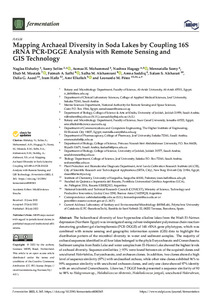Por favor, use este identificador para citar o enlazar este ítem:
https://repositorio.uca.edu.ar/handle/123456789/14809| Campo DC | Valor | Lengua/Idioma |
|---|---|---|
| dc.contributor.author | Elshafey, Naglaa | es |
| dc.contributor.author | Selim, Samy | es |
| dc.contributor.author | Mohammed, Asmaa H. | es |
| dc.contributor.author | Hagagy, Nashwa | es |
| dc.contributor.author | Samy, Mennatalla | es |
| dc.contributor.author | Mostafa, Ehab M. | es |
| dc.contributor.author | Safhi, Fatmah A. | es |
| dc.contributor.author | Saddiq, Amna | es |
| dc.contributor.author | Alsharari, Salam S. | es |
| dc.contributor.author | Aseel, Dalia G. | es |
| dc.contributor.author | Hafiz, Iram | es |
| dc.contributor.author | Elkelish, Amr | es |
| dc.contributor.author | Pérez, Leonardo Martín | es |
| dc.date.accessioned | 2022-08-29T12:02:31Z | - |
| dc.date.available | 2022-08-29T12:02:31Z | - |
| dc.date.issued | 2022 | - |
| dc.identifier.citation | Elshafey, N., et al. Mapping archaeal diversity in soda lakes by coupling 16S rRNA PCR-DGGE analysis with remote sensing and GIS technology [en línea]. Fermentation. 2022, 8(8), 365, doi:10.3390/fermentation8080365 Disponible en: https://repositorio.uca.edu.ar/handle/123456789/14809 | es |
| dc.identifier.issn | 2311-5637 | - |
| dc.identifier.uri | https://repositorio.uca.edu.ar/handle/123456789/14809 | - |
| dc.description.abstract | Abstract: The haloarchaeal diversity of four hypersaline alkaline lakes from the Wadi El-Natrun depression (Northern Egypt) was investigated using culture-independent polymerase chain reaction-denaturing gradient gel electrophoresis (PCR-DGGE) of 16S rRNA gene phylotypes, which was combined with remote sensing and geographic information system (GIS) data to highlight the distribution pattern of the microbial diversity in water and sediment samples. The majority of archaeal sequences identified in all four lakes belonged to the phyla Euryarchaeota and Crenarchaeota. Sediment samples from Beida Lake and water samples from El-Hamra Lake showed the highest levels of archaeal diversity. Sequence similarities ≥ 95% were found between six of the acquired clones and uncultured Halorhabdus, Euryarchaeota, and archaeon clones. In addition, two clones shared a high level of sequence similarity (97%) with unclassified archaea, while other nine clones exhibited 96% to 99% sequence similarity with uncultured archaeon clones, and only one clone showed 97% identity with an uncultured Crenarchaeota. Likewise, 7 DGGE bands presented a sequence similarity of 90 to 98% to Halogranum sp., Halalkalicoccus tibetensis, Halalkalicoccus jeotgali, uncultured Halorubrum, Halobacteriaceae sp., or uncultured haloarchaeon. In conclusion, while the variety of alkaliphilic haloarchaea in the examined soda lakes was restricted, the possibility of uncovering novel species for biotechnological applications from these extreme habitats remains promising. | es |
| dc.format | application/pdf | es |
| dc.language.iso | eng | es |
| dc.publisher | MDPI | es |
| dc.rights | Acceso abierto | * |
| dc.rights.uri | http://creativecommons.org/licenses/by-nc-sa/4.0/ | * |
| dc.source | Fermentation. 2022, 8(8), 365 | es |
| dc.subject | HALOARQUEAS | es |
| dc.subject | BIOTECNOLOGIA | es |
| dc.subject | BIODIVERSIDAD | es |
| dc.title | Mapping archaeal diversity in soda lakes by coupling 16S rRNA PCR-DGGE analysis with remote sensing and GIS technology | es |
| dc.type | Artículo | es |
| dc.identifier.doi | 10.3390/ fermentation8080365 | - |
| uca.disciplina | INGENIERIA AMBIENTAL | es |
| uca.issnrd | 1 | es |
| uca.affiliation | Fil: Elshafey, Naglaa. Al-Arish University. Faculty of Science. Botany and Microbiology Department; Egipto | es |
| uca.affiliation | Fil: Selim, Samy. Jouf University. College of Applied Medical Sciences. Department of Clinical Laboratory Sciences; Arabia Saudita | es |
| uca.affiliation | Fil: Mohammed, Asmaa H. National Authority for Remote Sensing and Space Sciences. Marine Sciences Department; Egipto | es |
| uca.affiliation | Fil: Hagagy, Nashwa. University of Jeddah. College of Science & Arts at Khulis. Department of Biology; Arabia Saudita | es |
| uca.affiliation | Fil: Hagagy, Nashwa. Suez Canal University. Faculty of Science. Botany and Microbiology Department; Egipto | es |
| uca.affiliation | Fil: Samy, Mennatalla. The Higher Institute of Engineering. Department of Communications and Computers Engineering; Egipto | es |
| uca.affiliation | Fil: Mostafa, Ehab M. Jouf University. College of Pharmacy. Department of Pharmacognosy. Arabia Saudita | es |
| uca.affiliation | Fil: Safhi, Fatmah A. Princess Nourah bint Abdulrahman University. College of Science. Department of Biology; Arabia Saudita | es |
| uca.affiliation | Fil: Salha M. Alshamrani. University of Jeddah. College of Science. Department of Biology; Arabia Saudita | es |
| uca.affiliation | Fil: Saddiq, Amna. University of Jeddah. College of Science & Arts at Khulis. Department of Biology; Arabia Saudita | es |
| uca.affiliation | Fil: Alsharari, Salam S. Jouf University. College of Science. Biology Department; Arabia Saudita | es |
| uca.affiliation | Fil: Aseel, Dalia G. City of Scientific Research and Technological Applications. Arid Lands Cultivation Research Institute. Plant Protection and Biomolecular Diagnosis Department; Egipto | es |
| uca.affiliation | Fil: Hafiz, Iram. University of Sargodha. Institute of Chemistry; Pakistán | es |
| uca.affiliation | Fil: Elkelish, Amr. Suez Canal University. Faculty of Science. Botany and Microbiology Department; Egipto | es |
| uca.affiliation | Fil: Pérez, Leonardo Martín. Pontificia Universidad Católica Argentina; Argentina | es |
| uca.affiliation | Fil: Pérez, Leonardo Martín. Consejo Nacional de Investigaciones Científicas y Técnicas; Argentina | es |
| uca.version | publishedVersion | es |
| item.grantfulltext | open | - |
| item.fulltext | With Fulltext | - |
| item.languageiso639-1 | en | - |
| crisitem.author.dept | Facultad de Química e Ingeniería del Rosario | - |
| crisitem.author.dept | Instituto de Investigaciones en Ingeniería Ambiental, Química y Biotecnología Aplicada (INGEBIO) | - |
| crisitem.author.orcid | 0000-0002-4125-3536 | - |
| crisitem.author.parentorg | Pontificia Universidad Católica Argentina | - |
| crisitem.author.parentorg | Facultad de Química e Ingeniería del Rosario | - |
| Aparece en las colecciones: | Artículos | |
Ficheros en este ítem:
| Fichero | Descripción | Tamaño | Formato | |
|---|---|---|---|---|
| mapping-archaeal-diversity.pdf | 6,79 MB | Adobe PDF |  Visualizar/Abrir |
Visualizaciones de página(s)
51
comprobado en 27-abr-2024
Descarga(s)
34
comprobado en 27-abr-2024
Google ScholarTM
Ver en Google Scholar
Altmetric
Altmetric
Este ítem está sujeto a una Licencia Creative Commons

